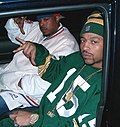Gang
Gang is a term used to describe a group of individuals who share a common identity and engage in illegal activities. The term is often associated with street gangs, which form on the streets of cities. However, gangs can also form in schools, prisons, and online communities.
Definition[edit]
A gang is defined as a group of three or more individuals who share a common identity and engage in illegal activities. This identity can be based on a variety of factors, including race, ethnicity, region, or criminal activity. Gangs are typically characterized by their use of violence to achieve their goals, which can include control of territory, increased power, or financial gain.
Types of Gangs[edit]
There are several different types of gangs, including:
- Street Gangs - These are the most common type of gang and are often associated with inner-city areas. Street gangs are typically involved in a variety of criminal activities, including drug trafficking, robbery, and violence.
- Prison Gangs - These gangs form within the prison system and are often involved in illegal activities both inside and outside of prison.
- School Gangs - These gangs form within schools and are often involved in activities such as bullying, drug dealing, and violence.
- Online Gangs - These gangs form online and are often involved in activities such as cybercrime, identity theft, and online harassment.
Gang Activities[edit]
Gang activities can vary widely depending on the type of gang and its goals. However, common activities include:
- Drug Trafficking - Many gangs are involved in the illegal drug trade, either by selling drugs themselves or by providing protection for drug dealers.
- Violence - Violence is often used by gangs to establish control over territory, to intimidate rivals, or to enforce loyalty among members.
- Robbery - Gangs often engage in robbery as a means of generating income.
Prevention and Intervention[edit]
There are a variety of strategies that can be used to prevent and intervene in gang activity, including:
- Community Policing - This involves building relationships between police and community members to help prevent crime.
- Education Programs - These programs aim to provide young people with the skills and opportunities they need to avoid joining a gang.
- Family Support Services - These services aim to strengthen families and provide support to parents in order to prevent youth from joining gangs.
See Also[edit]
Ad. Transform your life with W8MD's Budget GLP-1 injections from $75


W8MD offers a medical weight loss program to lose weight in Philadelphia. Our physician-supervised medical weight loss provides:
- Weight loss injections in NYC (generic and brand names):
- Zepbound / Mounjaro, Wegovy / Ozempic, Saxenda
- Most insurances accepted or discounted self-pay rates. We will obtain insurance prior authorizations if needed.
- Generic GLP1 weight loss injections from $75 for the starting dose.
- Also offer prescription weight loss medications including Phentermine, Qsymia, Diethylpropion, Contrave etc.
NYC weight loss doctor appointmentsNYC weight loss doctor appointments
Start your NYC weight loss journey today at our NYC medical weight loss and Philadelphia medical weight loss clinics.
- Call 718-946-5500 to lose weight in NYC or for medical weight loss in Philadelphia 215-676-2334.
- Tags:NYC medical weight loss, Philadelphia lose weight Zepbound NYC, Budget GLP1 weight loss injections, Wegovy Philadelphia, Wegovy NYC, Philadelphia medical weight loss, Brookly weight loss and Wegovy NYC
|
WikiMD's Wellness Encyclopedia |
| Let Food Be Thy Medicine Medicine Thy Food - Hippocrates |
Medical Disclaimer: WikiMD is not a substitute for professional medical advice. The information on WikiMD is provided as an information resource only, may be incorrect, outdated or misleading, and is not to be used or relied on for any diagnostic or treatment purposes. Please consult your health care provider before making any healthcare decisions or for guidance about a specific medical condition. WikiMD expressly disclaims responsibility, and shall have no liability, for any damages, loss, injury, or liability whatsoever suffered as a result of your reliance on the information contained in this site. By visiting this site you agree to the foregoing terms and conditions, which may from time to time be changed or supplemented by WikiMD. If you do not agree to the foregoing terms and conditions, you should not enter or use this site. See full disclaimer.
Credits:Most images are courtesy of Wikimedia commons, and templates, categories Wikipedia, licensed under CC BY SA or similar.
Translate this page: - East Asian
中文,
日本,
한국어,
South Asian
हिन्दी,
தமிழ்,
తెలుగు,
Urdu,
ಕನ್ನಡ,
Southeast Asian
Indonesian,
Vietnamese,
Thai,
မြန်မာဘာသာ,
বাংলা
European
español,
Deutsch,
français,
Greek,
português do Brasil,
polski,
română,
русский,
Nederlands,
norsk,
svenska,
suomi,
Italian
Middle Eastern & African
عربى,
Turkish,
Persian,
Hebrew,
Afrikaans,
isiZulu,
Kiswahili,
Other
Bulgarian,
Hungarian,
Czech,
Swedish,
മലയാളം,
मराठी,
ਪੰਜਾਬੀ,
ગુજરાતી,
Portuguese,
Ukrainian











